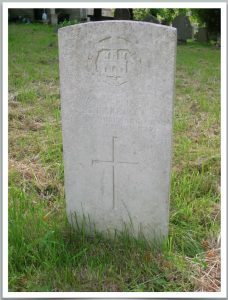7th Battalion, Dorsetshire Regiment

Based on the age given at his enlistment into the Army shown as 19 years and 69 days, Bert Parrott would have been born on 6 September 1895. However, it transpires he gave false information at the time and his ‘Date of birth vide Birth Certificate 13/8/99’ was found to be written on the side of his declaration.
Unfortunately, no record of his birth has been found in the BMD Indexes.
The military and documentary records available for Bert accredit him with serving in the Dorsetshire and also the Worcestershire Regiment.
He is recorded in the Soldiers who Died in the Great War as being enlisted at Bristol into the 7th Battalion, Dorsetshire Regiment and his Theatre of War was given as Home. According to the CWGC, and the inscription on his memorial, he served in the 7th Dorsetshire Regiment/Training Reserve Company and his Service Number was 8/9558.
It is noted in the Army Register of Soldiers’ Effects 1901-1929 (RSE) that a Berk (a transcription error for Bert) Parrott’s (TR 8/9558) unit was ‘35 TR Batt’ (35th Training Reserve Battalion) – this would link him to the 8th Reserve Brigade.
The record also states that a war gratuity was ‘not admissible’, and normally this would indicate less than six months service at home prior to his death.
His Pension Record states that he joined the 13th Worcester Regiment in Cirencester on 14 November 1914, aged 19 years and 69 days and was allocated Service Number 19485.
He was 5 feet 5½ inches, a Carter, he resided at Rose Cottage, Sherborne, Gloucestershire, and his father, Frederick Parrott, Eastrop, Highworth, Wiltshire, was given as his Next of Kin (NOK).
Bert was stationed at Torpoint, Cornwall from 3 November 1914; Looe, Cornwall from 8 December 1914; Wareham, Dorset from 28 May 1915; and Swanage, Dorset from 17 August 1915.
He was provisionally appointed Lance Corporal on 13 August 1915 but he was then deprived of his stripe on 15 November 1915, for unknown disciplinary reasons.
The 9th (Service) Battalion of the Worcesters (39th Brigade, 13th Division) had landed on Gallipoli on 13 July 1915, as part of the Mediterranean Expeditionary Force (MEF).
Bert was posted to the MEF effective 28 August 1915. The battalion was located in Salt Lake Trenches, near Lala Baba, adjacent to Suvla Bay in early September and spent seventeen days there, during which it received reinforcement drafts of 120 men and three officers and 260 men and three officers, respectively.
Almost certainly Bert Parrott was included in one of these drafts. For the rest of September and through to 20 December the battalion remained in the Suvla sector, at Sulajik Farm.
It took part in no major actions but was subjected to constant engagement with Turkish forces, throughout this time. On 20 December the battalion was taken off the Gallipoli Peninsular and disembarked on the nearby island of Imbros.
On the 28th it was back on the Peninsular at Cape Helles before finally being evacuated to the island base of Mudros on 8 January 1916.
Medical facilities on Mudros were limited and in common with many of the sick and wounded from Gallipoli, Bert as admitted into Mtarfa Royal Navy Military Hospital, Malta, on 15 January 1916, suffering from paratyphoid (a bacterial infection caused by a Salmonella enteric) and remained there until 21 March 1916.
He was invalided on the hospital ship Egypt to Netley (The Royal Victoria) Military Hospital, near Southampton, Hampshire, England, where he was admitted on 4 April 1916.
He was transferred to Woldingham Enteric Depot, a Military Hospital in Surrey on 12 May 1916 and was discharged on 29 June 1916.
On 11 July 1916 he was posted to Tregantle Fort, Antony, Cornwall as part of ‘D’ Company, 5th (Reserve) Battalion, Worcestershire Regiment where he remained until he was discharged from the army on 19 September 1916 for ‘making a misstatement as to his age on enlistment’.
His age on discharge was given as 21 years and four days (based on his declared age plus service of one year and 311 days), with a note that his age in accordance with birth certificate was 17 years and 37 days.
On his discharge papers, his character reference from the Commanding Officer of the 5th Battalion, Worcestershire Regiment stated: ‘This man to the best of my belief is sober, honest, and trustworthy’.
I guess that a little white lie about his age didn’t affect his honesty! Also, a punishment, handed out on 1 September 1916, of being confined to barracks for eight days, for being late for fatigues and making insubordinate remarks to an NCO, appears to have been overlooked!
Bert was awarded the 1914-15 Star along with the British War and Victory medals for his service with the Worcester Regiment.
As stated earlier, his father Frederick Parrott was noted as his NOK when he enlisted, and his mother Harriett, Sherborne, Northleach, Gloucestershire was his NOK on his Pension Records.
Supposition
From the available military records there is no mention of him being transferred to the Dorsetshire Regiment. As the minimum age was 18 years, the theory is that having joined the army aged 15 with the Worcester Regiment he was discovered to be underage in 1916 when he was 17 and therefore discharged.
It would appear that he managed to sign up again after discharge, possibly due to his previous military service and experience, and may have been sent to a different regiment to disguise his return to service.
Bert died of measles and Bronchial Pneumonia on 31 March 1917 aged 17.
He was buried in the Sherborne Churchyard Extension, which belongs to St Mary Magdalene’s Church.
His grave is marked with a standard CWGC headstone and he is commemorated on the Sherborne War Memorial.
A Roll of Honour for the Sherborne men who served in the Great War is held in St Mary Magdalene’s Church, Sherborne.
Researched by Baden Russell May 2021
